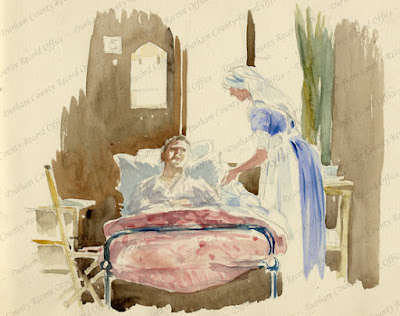Before the First World War, a few kilometres east of Ypres on the Menin road lay the small village of Hooge. Hooge was no more than a handful of houses and farm buildings, but set back some 200 metres north of the road there was a large red-brick chateau and stables.
By the early summer of 1915, Hooge lay in ruins and no man’s land ran between the chateau and stables, then on 19 July a British mine was exploded under the German trenches, leaving a crater 40 metres across and 12 metres deep. Into this still-smoking crater rushed British soldiers. From the lip of the crater, the nearest German trenches were only five metres away. Less than two weeks later, on 30 July, the Germans launched a surprise attack, blowing up the stables and then, using flame-throwers for the first time against British soldiers, capturing all of Hooge and driving the terrified defenders away from the Menin road south towards Sanctuary Wood.
 |
| D/DLI 2/2/213 A view of the Hooge crater showing sandbags and other debris from German dugouts, August 1915 |
General Plumer, commanding the British Second Army at Ypres,
ordered an attack to recapture the lost ground and the 6th Division was given
the task. Not only did this include the
2nd Battalion, Durham Light Infantry, they were chosen to lead the attack. *
Just after midnight on Monday 9 August 1915, rum was issued
to each man and two hours later 2 DLI was in position on the northern edge of
Sanctuary Wood. In addition to the usual weapons and equipment, they had to
carry additional rifle ammunition, sandbags and shovels, plus one day's ration
and a full water bottle. These men were about to attack at night across 500
metres of rising ground, hindered by shell holes, broken trees, shattered
trenches, barbed wire and the unburied dead from the earlier fighting.
At 2.45am, the British artillery opened fire. Twenty minutes
later, the Durhams advanced as near as was possible to the German front line
and lay down to await the end of the shelling. At exactly 3.15am, the
bombardment lifted and the Durhams attacked.
An account of this attack was recorded in a letter by an
unidentified private, published a newspaper:
"Our artillery opened fire and they replied. It was
simply awful but we lay there waiting for the order to charge. It came and we
lost all control of our senses and went like mad, fighting hand to hand and
bayoneting. We got into the first line and went straight on and then dug
ourselves in under hell's flames." (D/DLI 2/2/47(1))
Advancing in short rushes, 2 DLI quickly reached the trenches
linking the crater, stables and Menin road. It was so dark with the smoke and
dust from the explosions that Captain Robert Turner, who led the assault
companies, later wrote: "It was difficult to know when we had reached our
objective. I remember prodding with my walking stick to locate the road." (D/DLI
2/2/50). The German defenders were
overwhelmed. Later 300 dead were counted around the stables and over 200 bodies
were seen in the crater. Many had been bayoneted.
By 6am, the Durhams were digging in on their newly-won
positions and, for the rest of the day, they held on despite the incessant
German bombardment. Again the anonymous soldier described the battle:
"There was nine of us digging this trench. I turned my
back one second and when I looked again - what a sight! I will remember it till
I die. Every man in the trench blown to atoms - arms, legs and heads staring
you in the face. You will hardly credit what I did… I sat down and lit a
Woodbine… I was stuck there by myself for sixteen hours and all the time a
heavy bombardment." (D/DLI 2/2/47(1))
That night, after the order to pull back had been given,
fewer than 170 soldiers and three officers returned to Sanctuary Wood. The order, however, had not got through to all
the surviving Durhams. Many had been isolated by the bursting shells and it was
nearly twenty-four hours later that the last of the men came back.
The fighting at Hooge had cost the lives of over 500 German
soldiers with a further 130 taken prisoner, whilst, of the 650 Durhams who had
waited in the darkness before the attack on Hooge began, some 60 were killed
and 330 wounded. A further 100 Durhams were also reported missing, though not
all of these men were later listed as having been killed.
 |
| D/DLI 2/2/360(102) March off of the colours at the Hooge Ball, 1954 |
Though almost forgotten today, the Battle of Hooge was not,
however, forgotten by the 2nd Battalion DLI, and every year, until the
battalion was finally disbanded in 1955, “Hooge Day” was celebrated. In the
Officers’ Mess, an oil painting hung as a constant reminder to young officers
of their battalion’s history; it is now looked after by the DLI Museum. The battle honour “Hooge 1915” can be found on the old DLI Colours hanging in
Durham Cathedral.
(Original text by Steve Shannon)
Further reading:
Nigel Cave, Sanctuary Wood and Hooge (Barnsley, 1993).
John Sheen, The Steel of the DLI: The 2nd Battalion of the
Durham Light Infantry at War 1914-1918 (Barnsley, 2010).
*2DLI, who were the first Durham Light Infantry battalion to
see action on the Western Front (from September 1914) still had many pre-war
professional soldiers in its ranks.






